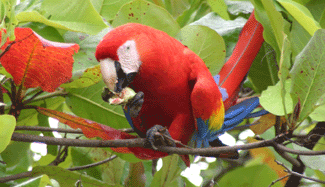The size of birds' brains is key for their survival

The brain is the organ in charge of processing, integrating and storing information on the surroundings, imposing limits on the learning capacity of the individual. Previous studies on birds and primates indicated that species with larger brains, in relation to their bodies, presented a greater capacity to modify their behaviour by learning. Animals which have to learn how to find food, avoid predators or select an appropriate habitat are more vulnerable during development than those that do so instinctively, as learning requires time and often carries with it risks. However, once learned, these behaviours may enable individuals to survive better in the face of a wide range of environmental risks, such as a scarcity of food, the appearance of new predators or changes in the habitat. The "cognitive buffer" theory suggests that species with larger brains are less vulnerable to external factors thanks to their greater capacity to respond to risks by adapting their behaviour. The theory predicts that species with large brains should show lower mortality rates.
To validate this prediction, the authors of the work-collected data published in the literature on annual mortality of species of birds, and compared these with the size of their brains. In the 220 species on which information was found, those with larger brains in relation to their size showed higher rates of mortality than those with smaller brains (Fig.1). The mortality rate may depend on many factors, such as migratory behaviour or the type of development of chicks, but the relation between brain and mortality seemed to be independent of these other factors.
Fig. 2. Relation between the size of brain, relative to body size, and annual mortality rates in birds.
These results have important implications for the understanding of the evolution of the brain, as it suggests that one of the benefits of having large brain is that of reducing the chance of dying from external factors. The result may also have implications on how animals respond to changes in their surroundings, such as climate change or the destruction of habitats. If species with larger brains have a greater capacity to respond to environmental problems by learned behaviour, we should also expect that they would be less affected by alterations in their surroundings. This possibility is, for the moment, a speculation, but it may be the object of verification in future research.
If having a large brain is so important for surviving in nature, why have not all birds developed large brains? In fact, there are many, such as ducks or partridges, which seem to function quite well with relatively small brains. In these species, the higher mortality of adults is compensated by a greater reproductive potential. Scientists believe that having a large brain is only useful for animals with life styles where learning plays a fundamental role. Even so, the scientific community has still to agree on what the conditions which favour these life styles are. Identifying these conditions is certainly complicated, but essential if we wish to understand how and why such large brains, such as those humans have, have evolved.
References
Sol, D., T. Szekely, A. Liker, and L. Lefebvre. En premsa. Big-brained birds survive better in nature. Proc. R. Soc. Lond. B.
Sol, D., R. P. Duncan, T. M. Blackburn, P. Cassey, and L. Lefebvre. 2005a. Big brains, enhanced cognition, and response of birds to novel environments. Proceedings of the National Academy of Science, USA 102:5460-5465.
Sol, D., L. Lefebvre, and J. D. Rodriguez-Teijeiro. 2005b. Brain size, innovative propensity and migratory behaviour in temperate Palearctic birds. Proceedings of the Royal Society of London, Series B 272:1471-2954.


